overheating CHEVROLET TRACKER 1998 1.G Owners Manual
[x] Cancel search | Manufacturer: CHEVROLET, Model Year: 1998, Model line: TRACKER, Model: CHEVROLET TRACKER 1998 1.GPages: 386, PDF Size: 21.17 MB
Page 121 of 386
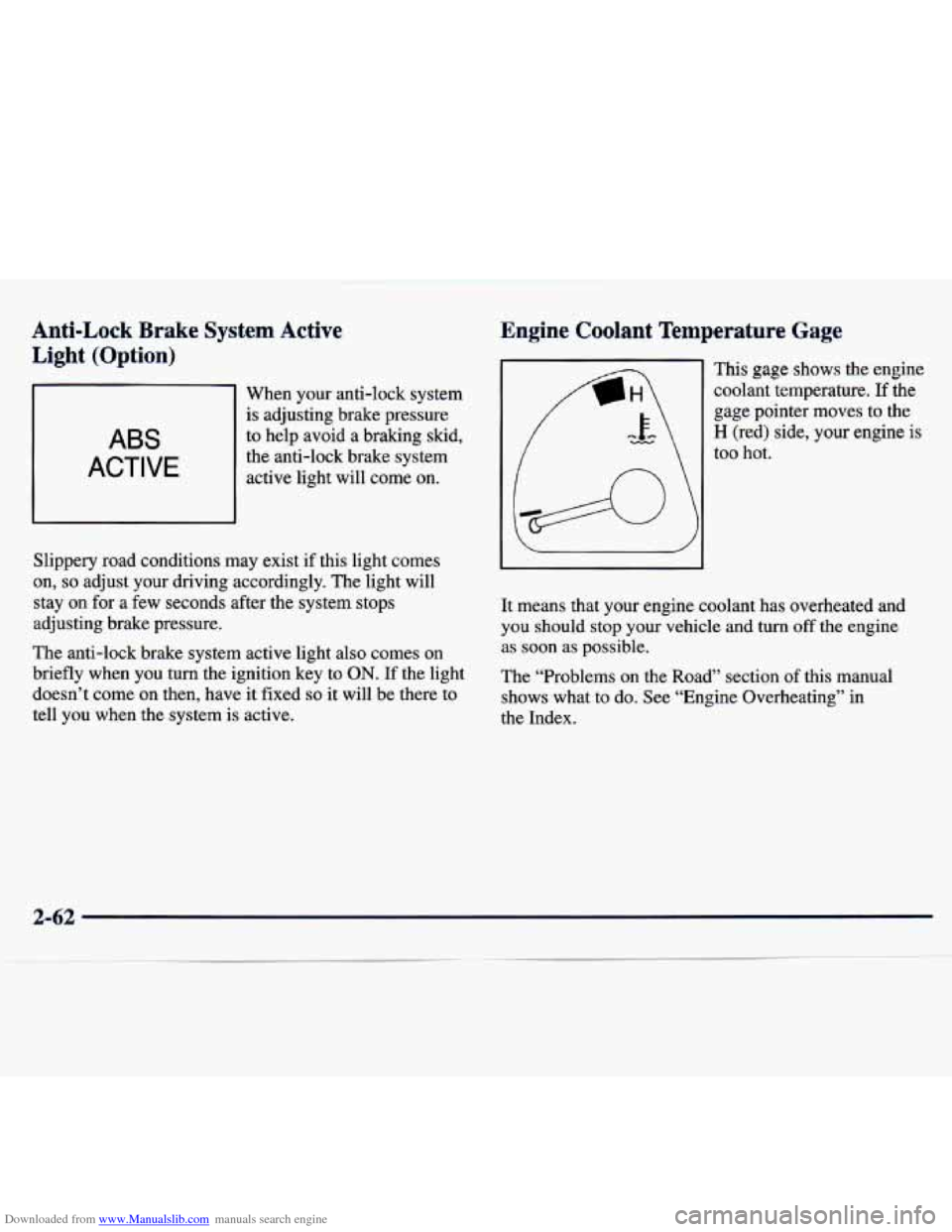
Downloaded from www.Manualslib.com manuals search engine Anti-Lock Brake System Active
Light (Option)
~
._.a
Engine Coolant Temperature Gage
ABS
ACTIVE
r 1
When your anti-lock system is adjusting brake pressure
to help avoid a braking skid,
the anti-lock brake system active light will come on.
Slippery road conditions may exist if this light comes
on,
so adjust your driving accordingly. The light will
stay on for a few seconds after the system stops
adjusting brake pressure.
The anti-lock brake system active light also comes on
briefly when you turn the ignition key to
ON. If the light
doesn’t come on then, have it fixed
so it will be there to
tell you when the system is active. This
gage shows the engine
coolant temperature. If the
gage pointer moves to the
H (red) side, your engine is
too hot.
It means that your engine coolant has overheated and
you should stop your vehicle and
turn off the engine
as soon as possible.
The “Problems on the Road” section of this manual
shows what to do. See “Engine Overheating’’ in
the Index.
2-62
Page 199 of 386
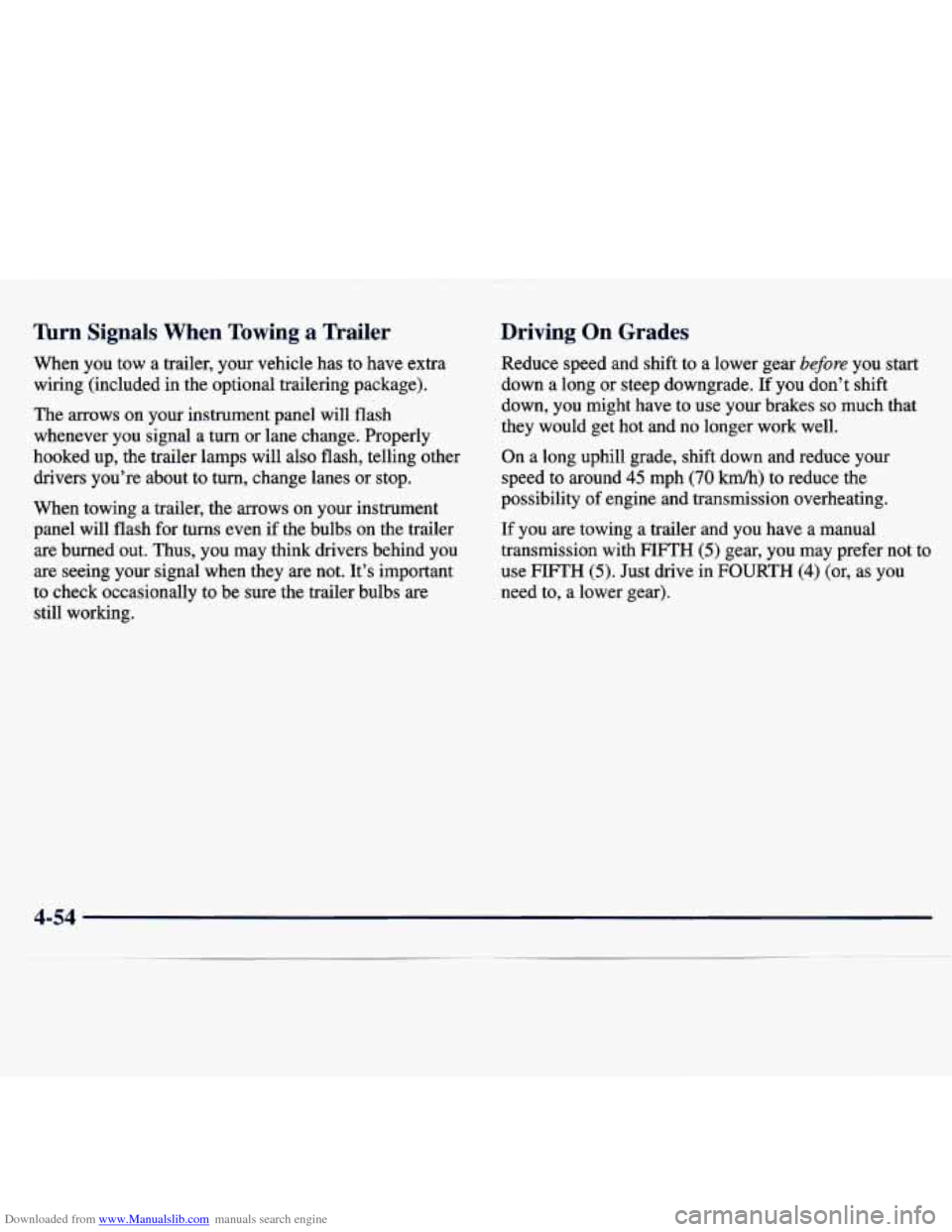
Downloaded from www.Manualslib.com manuals search engine lbrn Signals When Towing a nailer
When you tow a trailer, your vehicle has to have extra
wiring (included in the optional trailering package).
The arrows on your instrument panel will flash
whenever you signal a
turn or lane change. Properly
hooked up, the trailer lamps will also flash, telling other
drivers you’re about to turn, change lanes or stop.
When towing a trailer, the arrows on your instrument
panel will flash for
turns even if the bulbs on the trailer
are burned out. Thus, you may think drivers behind you
are seeing your signal when they
are not. It’s important
to check occasionally to be sure the trailer bulbs are still working.
Driving On Grades
Reduce speed and shift to a lower gear before you start
down a long or steep downgrade.
If you don’t shift
down, you might have to use your brakes
so much that
they would get hot and no longer work well.
On a long uphill grade, shift down and reduce your
speed to around
45 mph (70 km/h) to reduce the
possibility of engine and transmission overheating.
If
you are towing a trailer and you have a manual
transmission with
FIFTH (5) gear, you may prefer not to
use FIFTH
(5). Just drive in FOURTH (4) (or, as you
need to, a lower gear).
4-54
Page 202 of 386
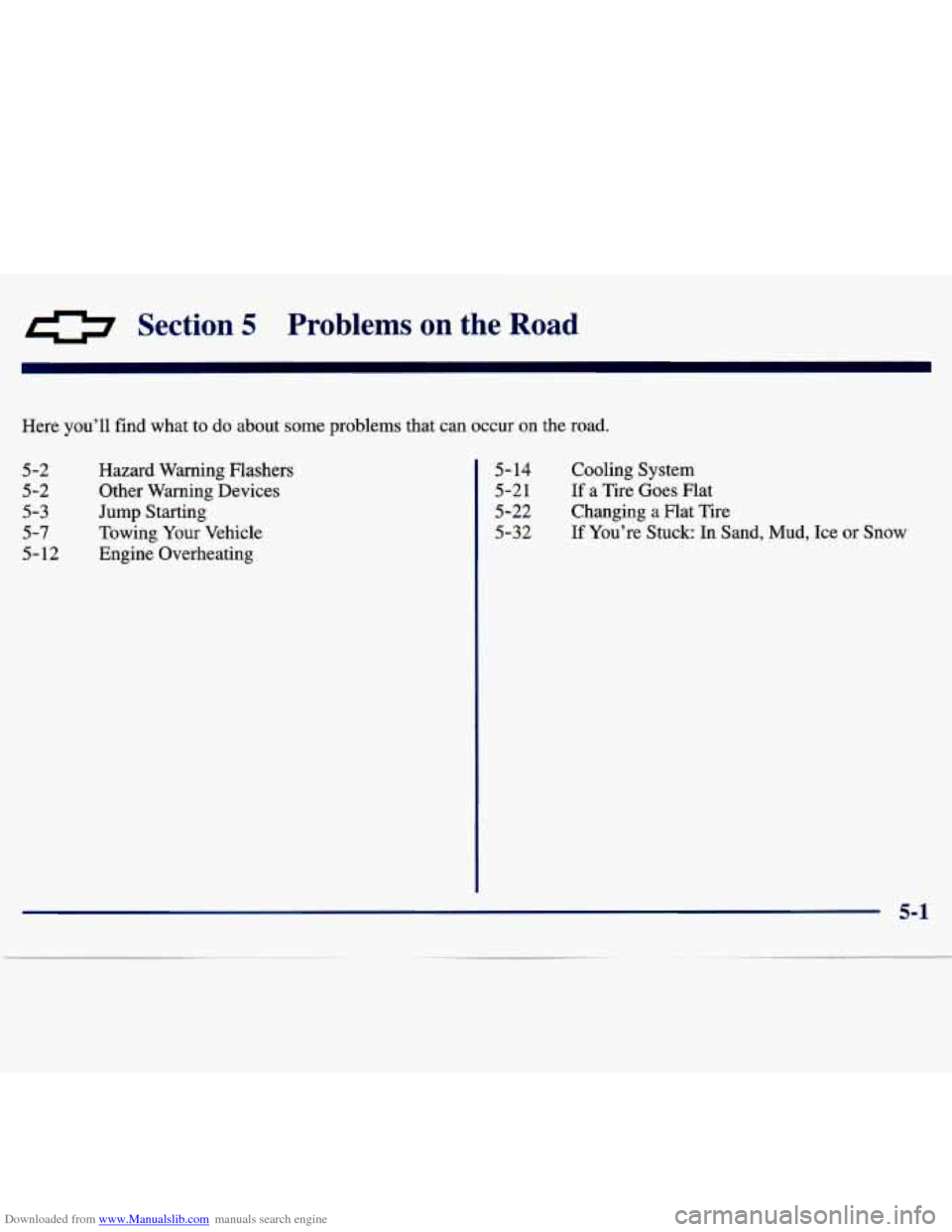
Downloaded from www.Manualslib.com manuals search engine 0 Section 5 Problems on the Road
Here you’ll find what to do about some problems that can occur on the road.
5-2 5-2
5-3
5-7
5-12 Hazard Warning Flashers
Other Warning Devices
Jump Starting
Towing
Your Vehicle
Engine Overheating
5- 14
5-21
5-22
5-32 Cooling System If a Tire Goes Flat
Changing a Flat Tire
If You’re Stuck: In Sand, Mud, Ice or Snow
5-1
Page 213 of 386
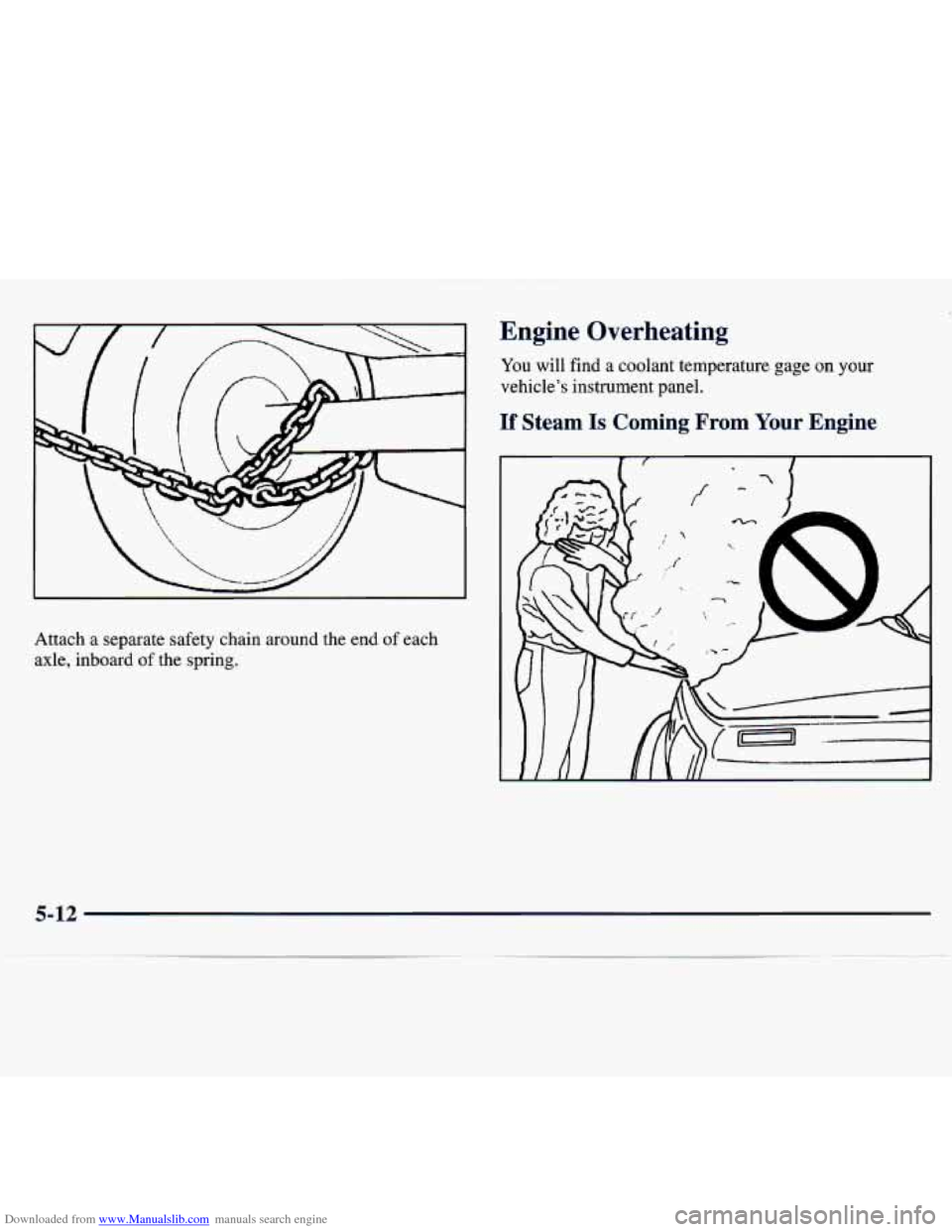
Downloaded from www.Manualslib.com manuals search engine I I I /
Attach a separate safety chain around the end
of each
axle, inboard of the spring.
Engine Overheating
You will find a coolant temperature gage on your
vehicle’s instrument panel.
If Steam Is Coming From Your Engine
5-12
Page 217 of 386

Downloaded from www.Manualslib.com manuals search engine I A
A C ,U ION:
Heater and radiator hoses, and other engine
parts, can be
very hot. Don’t touch them. If you
do, you can be burned.
Don’t run the engine if there is
a leak. If you run
the engine, it could lose all coolant. That could
cause an engine fire, and you could be burned.
Get
any leak fixed before you drive the vehicle.
NOTICE:
Engine damage from running your engine
without coolant isn’t covered by your warranty.
If there seems to be no leak, with the engine on, check to
see if the electric engine cooling fan
is running. If the
engine is overheating, the fan should be running. If it
isn’t, your vehicle needs service.
How to Add Coolant to the Coolant
Recovery Tank
If you haven’t found a problem yet, but the coolant
level isn’t at or above the
FULL mark, add a 50/50
mixture of clean water (preferably distilled) and a
proper coolant at the coolant recovery tank. (See
“Engine Coolant” in the Index for more information
about
the proper coolant mixture.)
Adding only plain water
to your cooling system
can be dangerous. Plain water, or
some other
liquid like alcohol, can boil before the proper
coolant mixture will. Your vehicle’s coolant
warning system is set for the proper coolant
mixture. With plain water or the wrong mixture,
your engine could get too hot but you wouldn’t
get the overheat warning. Your engine could
catch fire and you or others could be burned.
Use a 50/50 mixture of clean water and a
proper coolant.
5-16
Page 261 of 386
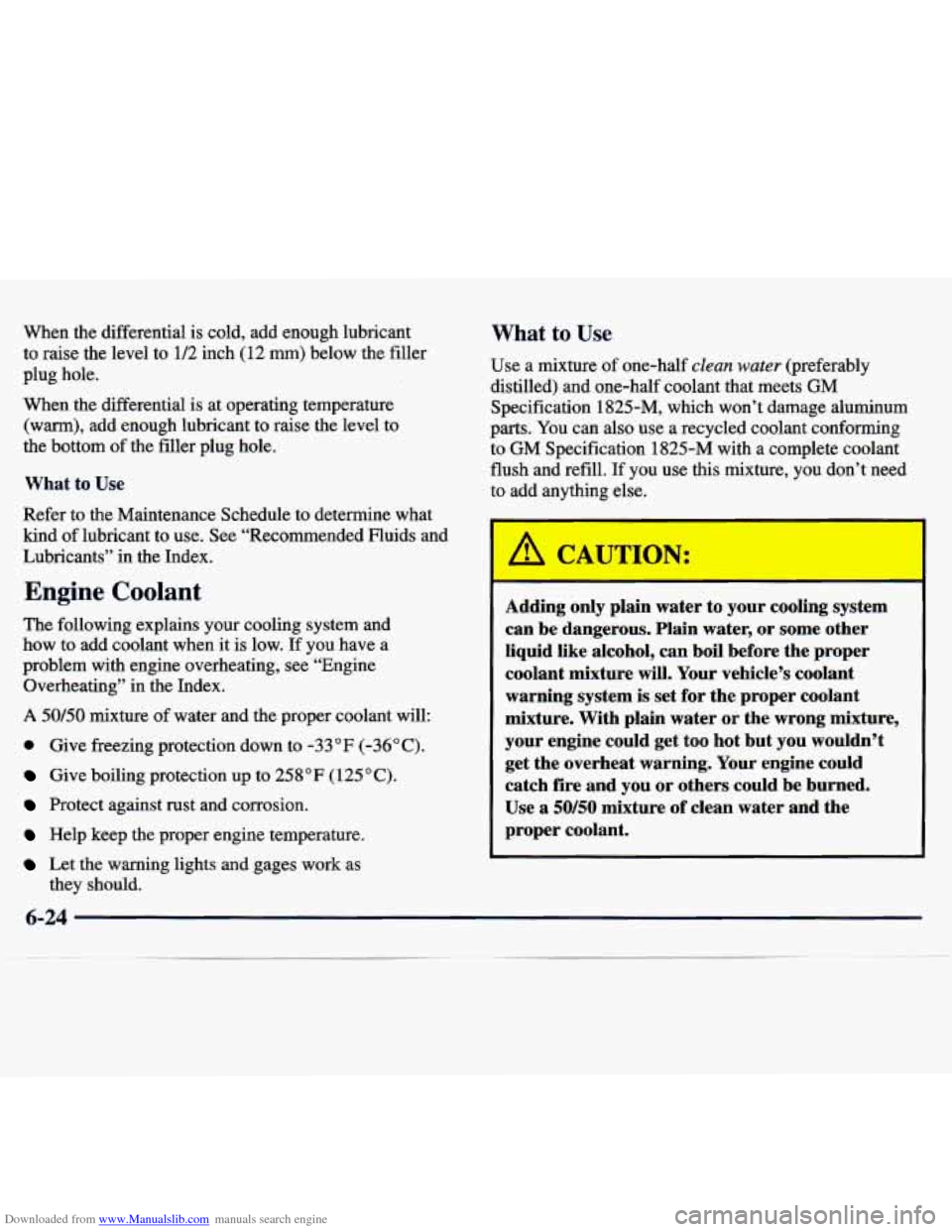
Downloaded from www.Manualslib.com manuals search engine When the differential is cold, add enough lubricant
to raise the level to 1/2 inch (12
mm) below the filler
plug hole.
When the differential is at operating temperature
(warm), add enough lubricant to raise the level to
the bottom
of the filler plug hole.
What to Use
Refer to the Maintenance Schedule to determine what
kind of lubricant to use. See “Recommended Fluids and
Lubricants” in the Index.
Engine Coolant
The following explains your cooling system and
how to add coolant when it is low. If you have a
problem with engine overheating, see “Engine
Overheating” in the Index.
A 50/50 mixture of water and the proper coolant will:
0 Give freezing protection down to -33°F (-36°C).
Give boiling protection up to 258 OF (1 25 O C).
Protect against rust and corrosion.
Help keep the proper engine temperature.
Let the warning lights and gages work as
they should.
What to Use
Use a mixture of one-half clean water (preferably
distilled) and one-half coolant that meets GM
Specification 1825-M, which won’t damage aluminum
parts.
You can also use a recycled coolant conforming
to GM Specification 1825-M with a complete coolant
flush and refill.
If you use this mixture, you don’t need
to add anything else.
Adding only plain water
to your cooling system
can be dangerous. Plain water, or some other
liquid like alcohol, can boil before the proper
coolant mixture will. Your vehicle’s coolant
warning system
is set for the proper coolant
mixture. With plain water or the wrong mixture,
your engine could get
too hot but you wouldn’t
get the overheat warning. Your engine could
catch fire and you or others could be burned.
Use a
50/50 mixture of clean water and the
proper coolant.
Page 263 of 386
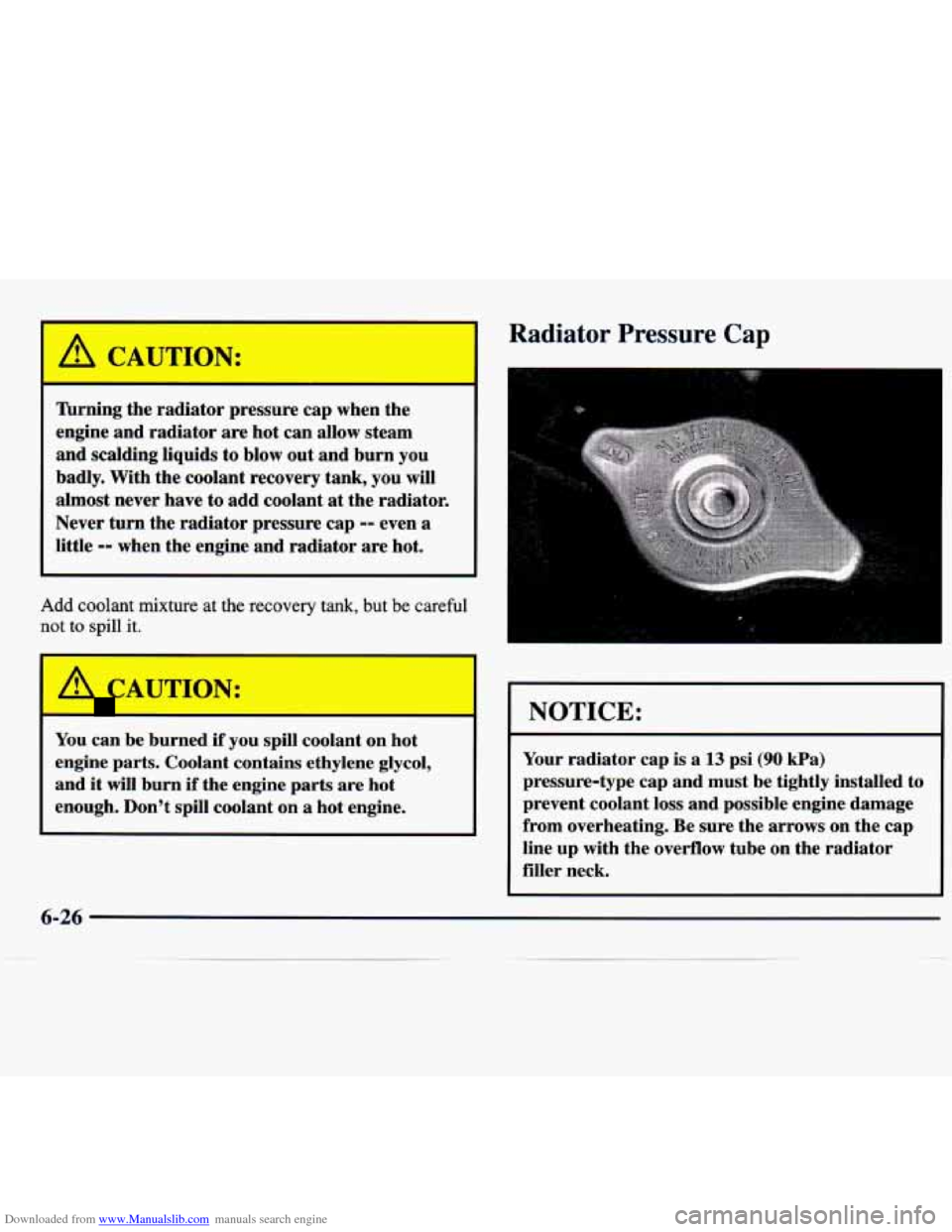
Downloaded from www.Manualslib.com manuals search engine A CAUTION:
Turning the radiator pressure cap when the
engine and radiator are hot can allow steam
and scalding liquids
to blow out and burn you
badly. With the coolant
recovery tank, you will
almost never have to add coolant
at the radiator.
Never turn the radiator pressure cap
-- even a
little -- when the engine and radiator are hot.
Add coolant mixture at the recovery tank, but be careful
not to
spill it.
You can be burned if you spill coolant on hot
engine parts. Coolant contains ethylene glycol,
and
it will burn if the engine parts are hot
enough. Don't spill coolant on
a hot engine.
Radiator Pressure Cap
*
NOTICE:
Your radiator cap is a 13 psi (90 kPa)
pressure-type cap and must be tightly installed to
prevent coolant
loss and possible engine damage
from overheating. Be sure the arrows on the cap
line up with the overflow tube on the radiator
filler neck.
6-26
Page 277 of 386

Downloaded from www.Manualslib.com manuals search engine Dome Lamp
0 Gently squeeze the dome lamp lens and remove it
0 Remove the bulb by gently opening the retaining
0 Insert a new bulb. Make sure that it is seated
from the lamp assembly.
clip and sliding the bulb out.
properly. lamp assembly.
0 Snap the dome lamp lens back into the dome
Tires
Your new vehicle comes with high-quality tires made by a leading
tire manufacturer. If you ever have questions
about your tire warranty and where to obtain service, see
your Chevrolet Warranty booklet for details. Poorly maintained
and improperly used tires
are dangerous.
Overloading your tires can cause
overheating
as a result of too much friction.
You could have an air-out and a serious
accident. See “Loading Your Vehicle” in
the Index.
Underinflated tires pose the same danger as
overloaded tires. The resulting accident
could cause serious injury. Check all tires
frequently to maintain the recommended
pressure. Tire pressure should be checked
when your tires are cold.
Overinflated tires are more likely to be cut,
punctured or broken by a sudden impact
--
such as when you hit a pothole. Keep tires
at the recommended pressure.
0 Worn, old tires can cause accidents. If your
tread is badly worn, or if your tires have
been damaged, replace them.
Ii
6-40
Page 377 of 386

Downloaded from www.Manualslib.com manuals search engine I
Easy Entry Seat ................................ 1-4
Electrical Equipment. Adding
................ 2.10. 6.57
Electrical System
............................... 6-57
Engine
....................................... 6-10
Coolant Level Check
.......................... 7-47
Coolant Temperature Gage
..................... 2-62
Exhaust
..................................... 2-27
Identification
................................ 6-57
Oil Level Check
.............................. 7-47
Overheating
................................. 5- 12
Running
We Parked ......................... 2-27
Specifications
................................ 6-6 1
Starting Your ................................. 2-9
Engine Compartment Main Fuse Block
.............. 6-60
Adding
..................................... 6-12
Coolant
..................................... 6-24
MainFuseBlock
............................. 6-60
Engineoil
.................................... 6-11
Additives
................................... 6-14
Checking
................................... 6-12
Used
....................................... 6-15
Whentochange
.............................. 6-14
Equipment, Adding
to the Outside of Your Vehicle ...... 6-3
What
Kind to Use ............................. 6-13
Ethan01
........................................ 6-4
Exhaust. Engine
................................ 2-27
Exterior Lamps
................................. 2-37
Fabric cleaning
............................... 6-49
Fifth
Gear. Manual Transmission ................... 2-16 Filling a Portable Fuel Container
.................... 6-7
Filling Your Tank
................................ 6-5
Filter.
Air ...................................... 6-16
Finishcare
.................................... 6-52
FinishDamage
................................. 6-55
First Gear, Manual Transmission
................... 2-15
Flashers, Hazard Warning
......................... 5-2
Flash-to-Pass Feature
........................... 2-31
Flat Tire, Changing
............................. 5-22
Capacities
................................... 6-62
Fluids and Lubricants
............................ 7-53
Foreign Countries, Fuel
........................... 6-5
Fourth Gear, Manual Transmission
................. 2-16
Four-wheel Drive
.................... 2-18,2-20, 6-22
Front Seat Side Pockets
.......................... 2-40
Fluid
Levelcheck
................................. 7-48
French Language Manual
u
FrontAxle .................................... 6-23
Front Sidemarker Lamp Bulb Replacement
........... 6-37
FrontTowing
................................... 5-9
Front
Turn Signal Lamp Bulb Replacement .......... 6-36
Fuel
.......................................... 6-3
Canada
...................................... 6-3
DoorLock ................................... 6-6
FillingYourTank
.............................. 6-5
Gage
....................................... 2-67
.. ...........................
Filling a Portable Container ...................... 6-7
In Foreign Countries
........................... 6-5
Fuses and Circuit Breakers
....................... 6-58
9-4
Page 380 of 386

Downloaded from www.Manualslib.com manuals search engine Malfunction Indicator Lamp ...................... 2-63
Manual Adjust Mirror
........................... 2-38
Manual Front Seat
............................... 1-2
Manual Transmission
............................. 2-9
Fluid
....................................... 6-20
Shifting
..................................... 2- 15
Starting Your Engine
........................... 2-9
Methanol
...................................... 6-4
Mirrors
....................................... 2-38
Convex Outside
.............................. 2-39
Manual Adjust
............................... 2-38
Power Remote Control
......................... 2-39
Model Reference
................................. vi
Mountain Roads
................................ 4-37
MultifunctionLever
............................. 2-30
MMT
......................................... 6-4
Automatic Transmission
....................... 2- 12
Manual Transmission
.......................... 2- 16
New Vehicle Break-In
............................ 2-7
Nightvision
................................... 4-30
Odometer
.................................... 2-57
Odometer. Trip
................................. 2-57
Off-Road Driving
.............................. 4- 15
Off-RoadRecovery
............................. 4-12
Oil. Engine
.................................... 6-11
Oil Pressure Light
......................... 2.65. 6. 11
Overdrive. Automatic Transmission ................ 2- 15 Overdrive
Off Light ............................. 2-66
Overheating Engine
............................. 5-12
Owner Checks and Services
....................... 7-47
Owner Publications. Ordering
..................... 8-11
Paint Spotting. Chemical
........................ 6-55
Park Automatic Transmission
....................... 2-11
Shifting Into
................................. 2-23
Shifting Out
of ............................... 2-25
AtNight
..................................... 2-7
Brake
...................................... 2-21
Brake Mechanism Check
....................... 7-50
Over Things That Burn ........................ 2-26
WithaTrailer
................................ 4-55
Your Vehicle. Manual Transmission
.............. 2-26
Parking Lamp Bulb Replacement
.................. 6-36
Passenger Position
......................... 1-25. 1-32
Passing
....................................... 4-12
Periodic Maintenance Inspections
.................. 7-51
Power DoorLocks
................................... 2-4
Indicator Light
............................... 2-66
Mode Selector Switch
......................... 2-14
Remote Control Mirror
........................ 2-39
Steering .................................... 4-10
Steering Fluid
................................ 6-27
Windows
................................... 2-29
Pregnancy. Use of Safety Belts
.................... 1-24
Parking